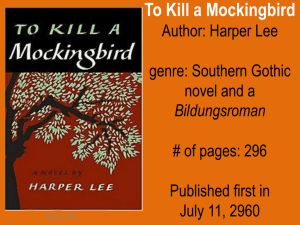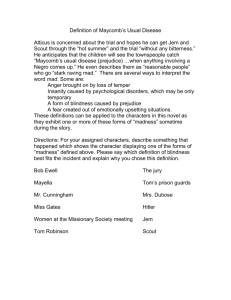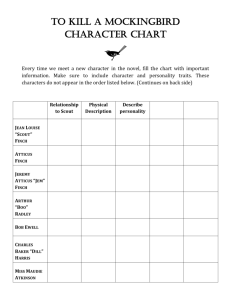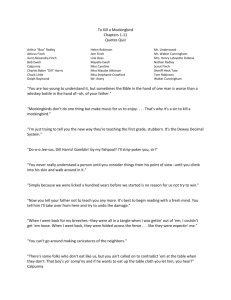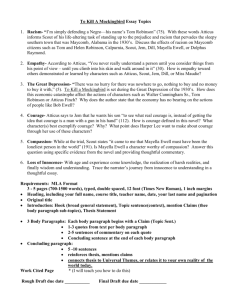NEW PwrPt To Kill a Mockingbird Intro 2015
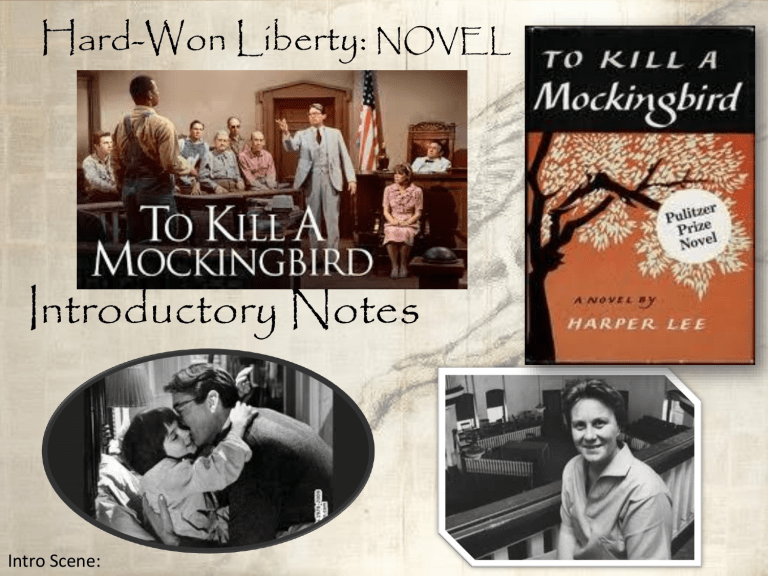
Hard-Won Liberty:
NOVEL
Introductory Notes
Intro Scene:
2015 -- Go Set a Watchman (1 st draft of TKAM)
To Kill a Mockingbird -
Movie
1962
Notes: Contents
• Historical Background
• CASTE-SYSTEMS
(aka people who lived during that time)
• Setting
• Characters
• Controversy/Banning
Historical Background
SETTING
– Maycomb, Alabama; 1933-1935
– Great Depression
– Time of Economic Struggle for many Americans
– Many families forced to rely on men to become migrant workers to provide for family
– Hitler in power in Germany
– VIDEO: http://www.teachertube.com/vide o/images-of-the-great-depression-
226296
– TIMELINE: http://www.pbs.org/wgbh/americ anexperience/features/timeline/ra ils-timeline/
Maycomb, Alabama
• Fictitious town based on real town of Montgomery, Alabama
• Welcome to small town Alabama, circa 1930s. It's a friendly town, with lots of old ladies baking cakes and small-town sheriffs saying folksy things.
• Oh, and it also has morphine-addicted old ladies; abusive families living by the dump; and a pretty nasty racial divide.
• To Kill a Mockingbird takes place in the fictional small Southern town of Maycomb in the 1930s (Tom's trial takes place in 1935). Slavery and the Civil War of the 1860s still loom large in the rearview mirror, but the civil rights movement of the 1950s and '60s is just a wee little speck on the horizon. And Maycomb is going nowhere fast:
“A day was twenty-four hours long but seemed longer. There was no hurry, for there was nowhere to go, nothing to buy and no money to buy it with, nothing to see outside the boundaries of
Maycomb County.” (1.10)
• Lots in its own little world, Maycomb doesn't know what's happening elsewhere and doesn't care. Few people move there (not much reason to) and few people leave (why bother?).
Source: http://www.shmoop.com/to-kill-a-mockingbird/setting.html
Historical Background
African-Americans
• The Great Depression of the 1930s worsened the already bleak economic situation of African Americans.
• They were the first to be laid off from their jobs, and they suffered from an unemployment rate two to three times that of whites.
• In early public assistance programs
African Americans often received substantially less aid than whites, and some charitable organizations even excluded blacks from their soup kitchens.
• Slavery was abolished in 1864, but
Southerners still believed in white supremacy.
• Segregation existed. African-Americans may not sit in the same sections as whites. They had separate facilities as well.
Source: http://www.britannica.com/EBchecked/topic/67474/African-
Americans/285193/African-American-life-during-the-Great-Depression-and-the-New-Deal
Historical Background
Other Minorities
–
• included Mexican Americans,
American Indians, and Asian
Americans
• Unemployment rate of 50% (compare to whites @ 25%)
• first to lose jobs at a business or on a farm
• often denied employment in public works programs supposedly available to all needy citizens
• sometimes threatened at relief centers when applying for work or assistance
• Some charities refused to provide food to needy minorities, particularly to blacks in the South.
• Violence against minorities increased during the Depression, as whites competed for jobs traditionally held
Source: http://www.encyclopedia.com/article-1G2-
Historical Background
• Gender Bias
– Women considered “the weaker sex”
– Education not important for women
– Wealthy women were expected to supervise staff
– In the 1930s, during the Great Depression, 26 states had laws prohibiting the employment of married women. The sentiment behind the laws was that a married woman – who presumably had a husband to take care of her
– should not "steal" a job from a man.
– It was acceptable for single women to find jobs, but usually these were lower-paying jobs that were typically considered "women’s work" – thus white women worked as.
– Working-class white women would hold jobs such as salesgirls, beauticians, schoolteachers, secretaries, and nurses
– The job market for African American women was even more restricted, with most black women who worked serving as maids, cooks, laundresses, boarding house and lodging house keeping and hairdressing and beauty culture.
– A good deal of women were wives and mothers while men provided for their families
– or, at least, attempted to do so.
Source: http://www.westga.edu/~hgoodson/Women%20and%20Work.htm
Working Women 1930s protesting
Historical Background
Poor White
Families
• Hard-working
• Honest
• Proud
• Men worked at various jobs in factories, farms, roadwork,
• Survived on very little
• Paid with “entailments” =
Always paid back their debts – even if it is with hickory nuts, turnips, or holly.
• The Cunninghams fit this category
Source: http://xroads.virginia.edu/~1930s2/Time/timefr.html
Historical Background
“Poor white trash”
• Dirty
• Lazy
• Good-for-nothing
• Never done a day’s work
• Foul-mouthed
• Dishonest
• Immoral
• The Ewells fit this category
Historical Background
The Black Community
• Simple & Honest
• Hard-working
• God fearing
• Proud
• Would never take anything without paying it back
• Respectful
• Had stronger character than most of the whites
• Oppressed
• Uneducated
• Discriminated against
• Talked about badly
• Deserve better than what is dished out to them by society
• Some examples from the book include Calpurnia and Tom
Robinson
Video: https://www.youtube.com/watch?v=mDS32LEe1Ss
CONTROVERSY/BANNING
• LINKS http://www.brighthubeducation.com/homework-help-literature/57011-why-was-to-kill-a-mockingbirdbanned/ http://bannedbooks.world.edu/2012/07/30/banned-books-awareness-to-kill-a-mockingbird/ http://dangerousbooks.wordpress.com/2008/05/01/to-kill-a-mockingbird/ http://www.npr.org/programs/atc/features/2001/aug/mockingbird/010807mockingbird.html
http://www.lansingcitypulse.com/lansing/article-4533-controversial-or-a-classic.html
http://www.tolerance.org/magazine/number-27-spring-2005/feature/books-under-fire http://www.westport-news.com/opinion/article/To-Kill-a-Mockingbird-Still-relevant-after-50-
500199.php
http://racerelations.about.com/b/2010/07/11/the-backlash-against-to-kill-a-mockingbird.htm
http://www.wset.com/story/13466620/controversy-over-n-word-in-to-kill-a-mockingbird http://ncacblog.wordpress.com/2010/11/05/florida-high-school-cancels-production-of-to-kill-amockingbird/ http://www.freedomtoread.ca/articles/teaching-controversy/ http://books.google.com/books?id=aeqIV1m_akQC&pg=PA197&lpg=PA197&dq=controversy+to+kill+a+ mockingbird&source=bl&ots=QYZvwomB6C&sig=wDVBMQXDbucCEMbTF0Pj9lfjTB8&hl=en&sa=X& ei=zU9yUt_uPOnPsASA94GYCw&ved=0CCwQ6AEwBDgK#v=onepage&q=controversy%20to%20kill%
20a%20mockingbird&f=false
TOP 5 MAIN REASONS
• BLATANT & OVERT RACISM PORTRAYED
• USE OF DEROGATORY LANGUAGE – “N” word
• MATURE TOPICS – RAPE, ALCOHOLISM, CHILD
ABUSE
• CHARACTER STEREOTYPES – gender, race, creed
• TRUTHFULNESS
Characters
Jean Louise Finch “Scout”
The story’s narrator
Although now an adult, Scout looks back at her childhood and tells of the momentous events and influential people of those years.
Scout is six yrs old when the story begins.
She is naturally curious about life
Tomboy who pals around with older brother and their summertime neighbor “Dill”
Mother passed away when she was 2 years old
Atticus Finch
Father of Scout and Jem
A widower
An attorney by profession
Highly respected
Good citizen
Instills good values and morals in his children
“Moral Compass” in the novel
Jeremy Atticus Finch – “Jem”
Scout’s older brother
Looks up to his father Atticus
Usually looks out for Scout
Typical older brother at times
Smart
Compassionate
Matures as the story progresses
Calpurnia – “Cal”
The Finch’s black housekeeper/maid/nanny
Has her own home/family
Has watched the children since their mother’s death
Has been a positive influence on the children
Can be a hard disciplinarian but loves the children as her own
Charles Baker
Harris – “Dill”
A close friend of Jem and Scout’s
Usually lives in Maycomb only during the summer (stays with a relative)
Tells “big stories”
Has been deprived of love and affection
Has single mom; later gets step-father
Tom Robinson
A young, harmless, innocent, hardworking black man
Accused of raping a white woman – facing trial
Has a disabled left hand
Married with three children.
Worked on a farm belonging to Mr. Link
Deas, a white man
Arthur Radley - “Boo”
An enigma
An adult man, whose father has
“sentenced” him to a lifetime confinement to their house because of some mischief he got into when he was a teenager.
Has a reputation of being a lunatic
Basically a harmless, wellmeaning person
Sometimes childlike in behavior
Starving for love and affection
Mayella Ewell
At 19, the oldest of the
Ewell family (8 kids total)
Shy & lonely
Mother passed away
a mother figure to her many siblings
Lives near town dump in filth with; very poor
Bob Ewell
Mayella’s poor “white trash” father
The town parasite who lives off the town’s bounty
Uses welfare checks for alcohol; rumored to physically abuse his children
Uncivilized man who has a negative reputation
Heck Tate
The town sheriff
Friends with Atticus
Present at the crime scene
Scene – key witness in trial
[Also important later during a related yet separate incident]
Aunt Alexandra
Atticus’s sister
Racist & disapproves of what her brother is doing
Wants Scout to be a lady
Wants Jem to be a gentleman
Stays with family during trial to provide some
“discipline”
Other Characters to Know
Judge Taylor The judge for the Robinson criminal trial
Mr. Gilmer
Dolphus Raymond
Reverend Sykes
Link Deas
The prosecutor who defends
Mayella Ewell
A white man married to a black woman w/ mulatto children
Minister of the black church that both Calpurnia and Tom
Robinson attend
Neighbor & Friend to many;
Stands up for Tom in court
Miss Maudie Atkinson
Scout’s Neighbor
Loves gardens and bakes the best cake in
Maycomb
Knows how to treat children like adults
Mrs. Henry Lafayette Dubose
A mean old woman in the Finch neighborhood
Teaches the children a lesson in bravery
